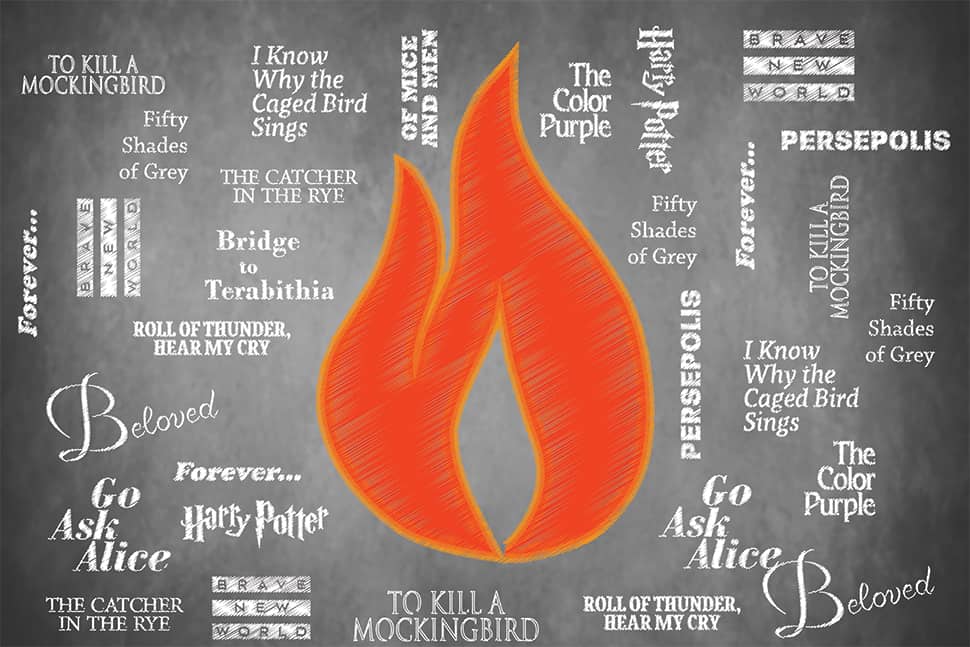It’s Fall again! It’s my favorite time of the year. Autumn brings beautiful colors, cooler weather (sweater weather — soon?), and the kids back in school. It also brings Banned Books Week, September 23-29. The American Library Association (ALA) began Banned Books Week in 1982 in response to a sudden surge in challenges to books in schools, stores and libraries. This year’s Banned Book Week theme is “Banning Books Silences Stories.”
Many of my favorite books have been banned or challenged books. Don’t get me wrong, I’m not saying that every book is created equal or that every book should be read and adored by all just because someone says it should (or shouldn’t). But whose stories are being silenced and who is doing the silencing? Just looking over a list of my own favorite banned books, many of the stories tend to be about the working poor, immigrants, minority groups, women, the unwell and the powerless.
Many books are challenged for sexual content. “The Immortal Life of Henrietta Lacks” by Rebecca Skloot, for example, tells the story of a black woman whose cancer cells were harvested and sold without her or her family’s knowledge. The book was challenged as being pornographic. The author’s response to the challenge was that the challenger must be confusing gynecology with pornography. The story of Henrietta Lacks is a true story, and she lives on in the research cells that still help scientists today. This book actually won the 2011 National Academies Communication Award for best creative work that helps the public understand topics in science, engineering or
medicine. Another example is the graphic novel “Fun Home” by Alison Bechdel. This book is about a young girl growing up with her closeted father and his subsequent death all while trying to find the courage to come out. It’s also been made into a really fun musical. Granted, these stories might not look like everyone’s world but it could be someone’s lived experience closer to you than you might know. There have been numerous studies and articles showing that reading about another person’s lived experience develops empathy.
Other books are challenged for political reasons. “A People’s History of the United States” by Howard Zinn has been condemned as being biased and un-American. Zinn, a Boston University political science professor, changed the way history is told by viewing it at a “grassroots” level through the lens of the “have-nots” rather than the “haves.” He often did this using first-hand accounts such as letters and speeches. Zinn was actually the target of a bill introduced in the Arkansas state legislature to prevent public schools from assigning any of his books and articles, and
that was not the first attempt to silence those stories. “Nickel and Dimed: On (Not) Getting by in America” by Barbara Ehrenreich was also challenged for political reasons (along with references to drug use, offensive language and religious viewpoints). Ehrenreich went undercover in various minimum wage jobs in several different locations in the country to see if it was possible to “get by.” Her conclusion in every case was a resounding “No!” but that put capitalism, or at least our current form of capitalism, in a bad light.
Another reason for challenging books seems to be a vague sense of protecting, or over-protecting, our babies. “The Fault in Our Stars” by John Green is a love story about two teens trying to live and survive cancer. This has been such a popular book, probably because it tugs on so many heartstrings. It has won numerous awards and been made into a major motion picture. TFIOS, as it is often referred to, has been challenged for making kids deal with mortality. I’m not even kidding. Do we really want our kids thinking they are immortal? We
also try to protect our kids from the realities of war, such as with “Persepolis,” a graphic novel by Marjane Satrapi about her experiences growing up during a revolution in Iran and the rise of the Taliban. It has been challenged for graphic language and images. I really like graphic novels for such difficult topics because “a picture tells a thousand words” and yet they are not as graphic as a photo would be. The graphic novel gives a small degree of separation from reality while still letting us face someone’s dreadful reality.
I understand wanting to protect our young children, but by the time they are in high school, and definitely by college, it’s time to prepare them for a bigger world and books offer such a wonderful way to do that. Even books that we might not agree with politically or religiously offer an opportunity for a conversation. They also give us a chance to develop empathy for someone who may be living a completely different experience than our own. And if we think that limiting exposure to all things sexual will keep kids from experiencing those feelings themselves, I think we are kidding ourselves. Wouldn’t it be better to approach these topics and have the discussions?
I can’t imagine NOT having read these books because they have expanded my world so much. Who would I be without having met Scout and Atticus, Huck Finn, Anne Frank, or Maya Angelou? What are your favorite banned books?



